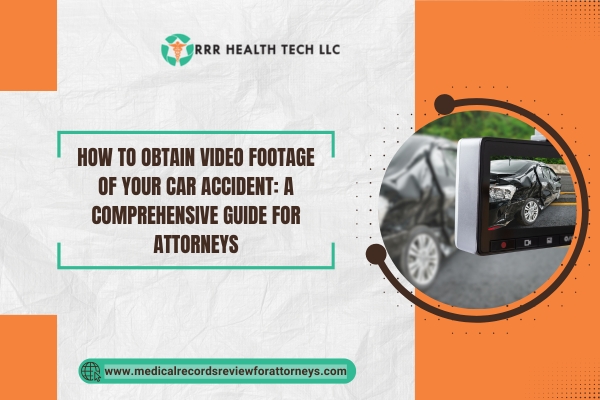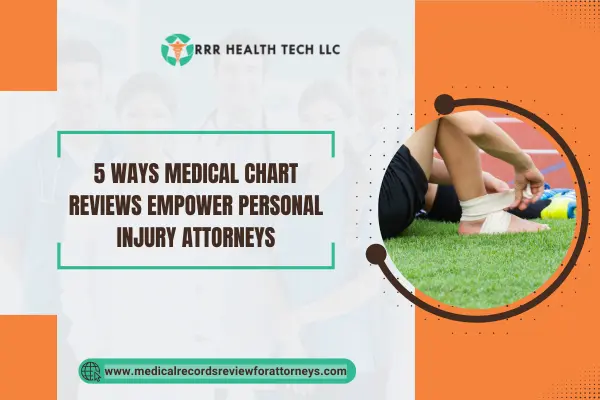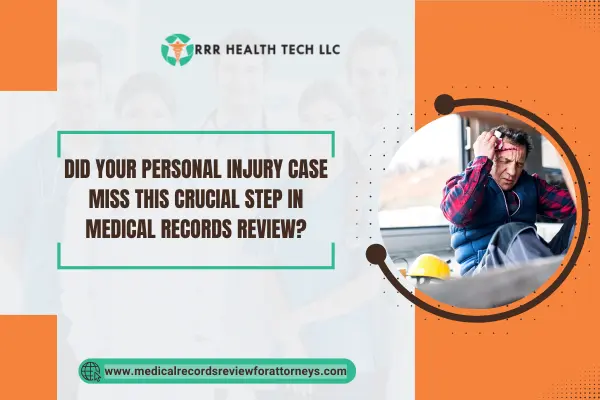
Introduction
Often following a car accident, video footage can be very helpful evidence that might establish liability and enhance your compensation claim. With numerous surveillance cameras and traffic monitoring systems, obtaining this type of footage is possible but often difficult. This article outlines the processes of getting video footage of a car accident or any available footage, as well as how our medical records review services can help lawyers build robust cases.
Understanding the Importance of Video Footage
Why Video Footage Matters
– Proof of Negligence: The actions of all the involved parties can be captured in video evidence and can help in proving fault.
– Enhancing Claims: Footage can bolster witness accounts and police reports thus improving your chances in court.
– Evidence: This type of footage is highly persuasive compared to other verbal accounts.
Types of Video Footage Available
Traffic Cameras Footage
– Where to Find It: Usually placed at junctions and primary arteries.
– Who to Contact: Normally, this is under the control of local governments or police departments.
Surveillance Camera Footage
• Sources: Can be collected from existent footage from public places, houses or even businesses.
• Challenges: Action must be taken urgently as recordings can be lost within a very short time span.
Dashcam Footage
• Personal Devices: A large number of car owners have a habit of mounting a camera in their car to record their trips.
• Eyewitness Footage: Other video files may include recordings made by other attendees of the event, whether they are car users or people on foot.
Cell Phone Footage
• Bystanders: People who were present at the scene of the incident might have captured it using their mobile phones.
• Importance: These footages can be highly beneficial to the case as they can capture details which other footages might not be able to.
Steps to Obtain Video Footage
Act Quickly
• Time Sensitivity: Circumventing their deletion within a negligible period of time by surveillance systems proves to be difficult. Therefore prompt action is vital.
Identify Potential Sources
• Traffic Cameras: Inquire about the presence of traffic CCTV cameras near the locale of the incident and check with the local transport authority.
• Surveillance Cameras: Look for shops and houses near the vicinity which might have CCTV cameras.
• Dashcam and Cell Phone Footage: Approach other vehicles and pedestrians who may have witnessed the incident and have captured it on their personal devices.
Contact the Relevant Authorities
• Traffic Camera Requests: Get in touch with your local police station or the appropriate authority for traffic cameras and request them for specific recordings. You need to give them information on the day and time the incident took place alongside the city and street.
• Surveillance Footage Requests: If obtaining footage becomes a challenge, the first step would be approaching business owners or property managers in person. They are likely to help, all you have to do is be polite and explain your situation to them.
• Legal Requests: If really needed, your lawyer can always issue a subpoena and force them to provide you with the required footage.
Document Everything
• Keep Records: Ensure that you document every step that you have taken in regards to acquiring the footage as well as every interaction that you or any of your employees have had. These can prove to be immensely helpful when desired legal actions have to be initiated.
How Video Footage is used in Car Accident Cases
Analyzing the Footage
• Determining Fault: As an example, your attorney could easily be able to locate a negligent act on your part, such as running a traffic light or failing to yield, and using that in their case.
• Corroborating Evidence: Videos can also help cross confirm other evidences such as police accounts and witness accounts that were made.
Legal Implications
• Negligence Claims: Eyewitnesses are not always reliable so videos help greatly when it comes to proving fault and liability on personal injury cases.
• Insurance Claims: Claiming for a payout entails a video being one of the primary pieces of evidence when securing an injury and having to assess your claim.
Common Challenges in Obtaining Video Footage
Limitations of Time
• Prompt Wipes: In a lot of surveillance systems, the footage is deleted within a certain time frame. It is best to get such footage as soon as possible.
Hinderance In Law
• Intrusive Policies: Some businesses will be doubtful in sharing the footage due to their privacy policies hindering them.
• Jurisdictional Issues: An example of this would be an interstate law regarding the release of footage, which are never the same in any two states.
Technical Difficulties
• Quality of Footage: The A/V quality, in particular the quality, resolution, and angle of the footage, can determine whether or not it is usable in court.
• Equipment Malfunctions: Cameras could have been malfunctioning during the time of the accident.
The Role of Medical Records Review
Importance for Attorneys
• Comprehensive Evidence: Attorneys utilize our medical record review services to collect and integrate medical documents and video records to systematically construct and dispassionately analyze evidence.
• Building Strong Cases: Proper medical documents can validate claims of concession expenses due to injuries from the accident.
Case Studies
Case Study 1: Traffic Camera Footage
• Overview: A driver got into an accident at a certain crowded point of an intersection.
• Challenges: The hardest part was proving that the other driver had a red light.
• Solutions: The attorney was able to obtain traffic camera footage when the other car does not stop at the stop light.
• Compensation: The evidence resulted in a positive outcome where the claimant’s medical and other related costs were honored.
Case Study 2: Surveillance Footage from a Business
• Overview: An accident happened near a retail shop , and the driver is claiming towards the injuries and wanted to get compensations.
• Problems: The owner was not willing to provide the recording because of privacy issues.
• Solutions: The lawyer justified the legal justification for acquiring the footage and made an official request. As a result, the footage showed important aspects of the accident.
• Compensation: The video footage was instrumental in obtaining a favorable settlement for the injured claimant.
Conclusion
Accessing video footage of the accident is a critical component in the specifics of the claim. Recognizing the different types of footage that can be captured, the processes to obtain it, and the potential obstacles that can be encountered are some of the ways in which attorneys can assist their clients. The review of medical records makes it easier to put a complete case together by ensuring that no relevant information is left out.


